Proton returns to flight successfully with EchoStar-21 (original) (raw)
Searching for details:
Related pages:
Proton crash with GLONASS satellites
Proton launch facilities in Baikonur
Proton returns to flight successfully with EchoStar-21
After a nearly year-long hiatus, Russia's workhorse Proton-M rocket lifted off on June 8, 2017, carrying the EchoStar-21 communications satellite. It was the first of as many as seven Proton launches planned for 2017.
Previous Proton mission: Intelsat-31
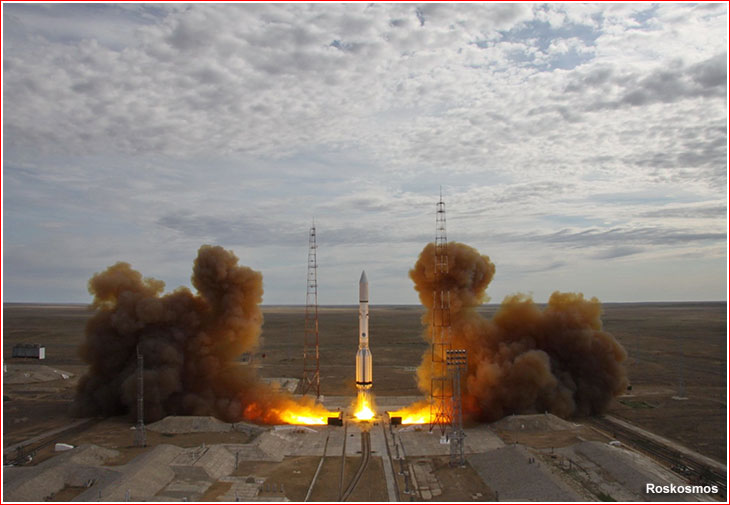
EchoStar-21 mission at a glance:
| Spacecraft designation(s) | EchoStar-21 |
|---|---|
| Launch vehicle | |
| Payload fairing | |
| Launch date and time | 2017 June 8, 06:45:47.008 Moscow Time (03:45:47 GMT) |
| Launch site |
From the publisher: Pace of our development depends primarily on the level of support from our readers!
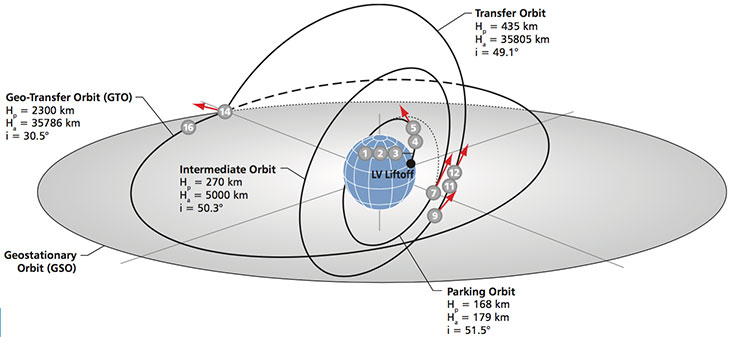
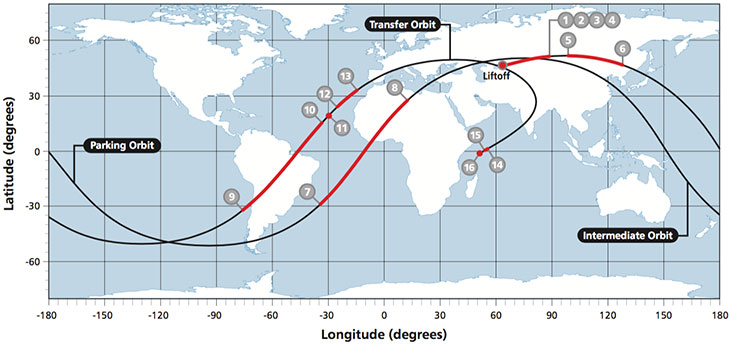
Ground track of the EchoStar-21 mission. Credit: ILS
| - | Event | Scheduled elapsed time |
|---|---|---|
| - | Liftoff | 0 |
| 1 | Stage I separation | 00:02:00 |
| 2 | Stage II separation | 00:05:26 |
| 3 | Payload fairing separation | 00:05:45 |
| 4 | Stage III separation | 00:09:41 |
| 5 | Briz-M firing 1 starts (Duration: 04:17) | 00:11:15 |
| 6 | Briz-M firing 1 ends | 00:15:32 |
| 7 | Briz-M firing 2 starts (Duration: 17:56) | 01:07:24 |
| 8 | Briz-M firing 2 ends | 01:25:20 |
| 9 | Briz-M firing 3 starts (Duration: 09:37) | 03:27:59 |
| 10 | Briz-M firing 3 ends | 03:37:36 |
| 11 | Briz-M jettisons its external tank | 03:38:26 |
| 12 | Briz-M firing 4 starts (Duration: 07:52) | 03:40:01 |
| 13 | Briz-M firing 4 ends | 03:47:53 |
| 14 | Briz-M firing 5 starts (Duration: 04:26) | 08:52:58 |
| 15 | Briz-M firing 5 ends | 08:57:24 |
| 16 | Spacecraft separation | 09:13:00 |
The liftoff of the 705-ton Proton-M/Briz-M launch vehicle with the 6.9-ton EchoStar-21 satellite took place as scheduled on June 8, 2017, at 06:45:47.008 Moscow Time (11:45 p.m. ET on June 7).
The ignition sequence was initiated at T-00:00:02.5 seconds before the physical separation of the 58.2-meter rocket from Pad 24 at Site 81 in Baikonur Cosmodrome, Kazakhstan.
At T-00:00:01.75 seconds, the six main engines of the first stage developed 40 percent of their required thrust, followed by 100 percent at T-00:00:00.9 seconds. As the rocket accelerated through the dense atmosphere, it experienced maximum dynamic pressure one minute and two seconds into the flight.
To deliver EchoStar-21, Proton followed a launch profile typical for most commercial missions. The first, second and third stages of the launch vehicle flew a standard ascent trajectory matching the orbital inclination of 51.5 degrees toward the Equator, placing the payload section including the Briz-M upper stage and the EchoStar-21 satellite into a sub-orbital trajectory.
In the following nine hours, Briz-M performed a total of five engine firings to boost the orbital unit first to a circular parking orbit, then to an intermediate orbit, followed by a transfer orbit, and, finally, to a geostationary transfer orbit.
Separation of the EchoStar21 satellite from the upper stage took place as scheduled 9 hours 13 minutes after liftoff into a highly elliptical orbit. The satellite is then expected to use its own propulsion system to enter the geostationary orbit 36,000 kilometers above the Equator.
Torturous road to the launch pad
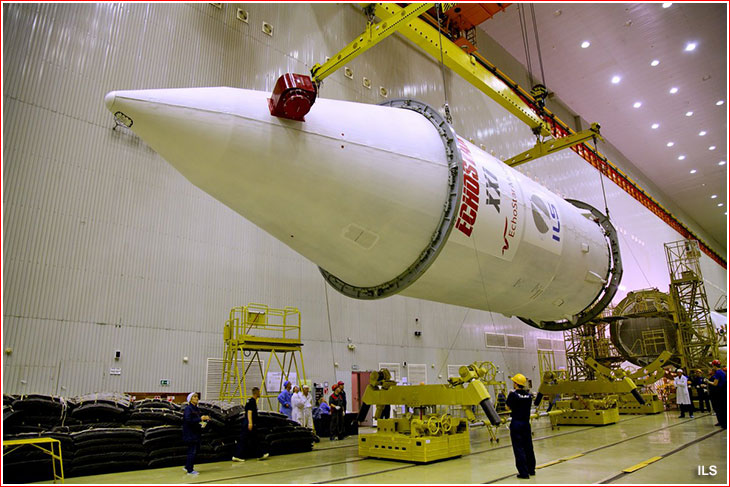
Payload section with the EchoStar-21 satellite is being prepared for integration with its Proton rocket in June 2017.
On May 13, 2013, the International Launch Services, ILS, which markets Proton to commercial customers outside Russia, announced an agreement to launch an EchoStar satellite. The mission was originally planned at the end of 2015 or beginning of 2016.
During 2016, the planned launch of EchoStar-21 was postponed to early June, then to June 25 and by the end of May, it was expected at the end of August 2016. However on July 28, 2016, Roskosmos announced another delay of the launch until Oct. 10, 2016, apparently to provide more time for the investigation into the problem with the operation of the Proton's second stage during the launch of the Intelsat-31 satellite in June 2016.
By Sept. 1, 2016, the launch of EchoStar-21 was postponed until November 23 of the same year. By October, the mission was pushed back to December, as GKNPTs Khrunichev needed more time to implement all the corrective actions to resolve the issue during launch of Intelsat-31. By mid-November, the company had finally set the path for the return to flight, targeting the launch of EchoStar-21 on December 22, 2016, at 19:26:34 Moscow Time. The spacecraft was delivered to Baikonur on November 22, however, the launch was then postponed until December 28, 2016, at 19:26:34 Moscow Time.
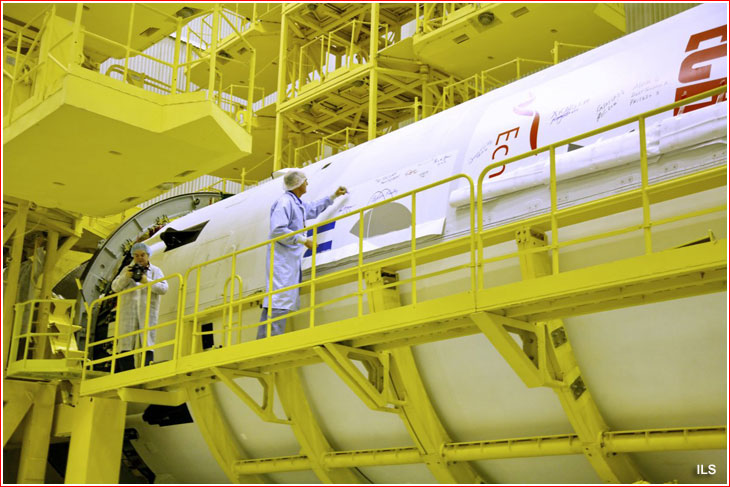
Participants of the EchoStar-21 launch campaign sign the fairing of the Proton rocket on Dec. 21, 2016.
By December 23, the satellite had already been integrated with the launch vehicle, when a newly discovered problem with the first stage of the rocket, discovered around a week before the planned liftoff, forced the postponement of the mission until January 2017, at the earliest. According to ILS officials, a failed component would be replaced at the launch site. As of December 27, the Proton was not expected to return to flight until the end of the third week of January 2017.
However during the first quarter of 2017, Roskosmos had to deal with a recall of multiple RD-0210 and RD-0212 engines used on the second and third stages of the Proton rocket.
In March, managers at Roskosmos and GKNPTs Khrunichev reviewed the provisional flight manifest for the Proton, should the repair work on the rocket's second- and third-stage engines be successful. In the meantime, officials from the International Launch Services, ILS, which markets Proton to commercial customers, briefed representatives of EchoStar on the details of the engine recall and the corrective measures.
Contingent on the success of the corrective actions, Russian officials hoped to return Proton to flight with the Echostar-21 satellite in May. According to the Russian press, this launch was previously expected as early as April 29.
By the end of April, Khrunichev officials reserved a range dates in Baikonur for the return-to-flight mission with the EchoStar-21 communications satellite from May 29 to May 31. A Baikonur-bound train carrying stages of the Proton rocket for the EchoStar-21 mission left the assembly factory in Moscow during the night from April 27 to April 28. The rocket arrived at Baikonur around May 8, however, due to May Day holidays and other delays, the mission had to be postponed once again until June 8, 2017.
On May 14, Briz-M was moved to the fueling area to load its high-pressure tanks, before the space tug could be integrated with its cargo.
Joint operations of the launch vehicle and its payload began inside processing building 92-A50 on May 30, 2017. On May 31, EchoStar-21 was integrated with its Briz-M upper stage and then lowered into horizontal position for encapsulation inside its payload fairing. The resulting payload section was then integrated with its Proton rocket.
The assembly of the Proton rocket was completed by June 3, 2017, and the launch vehicle was rolled out from the processing building to the Briz-M fueling site. On June 4, the State Commission overseeing the launch approved the rollout of the vehicle to the launch pad. The rocket arrived to the launch pad on the morning of June 5, 2017.
EchoStar-21 satellite
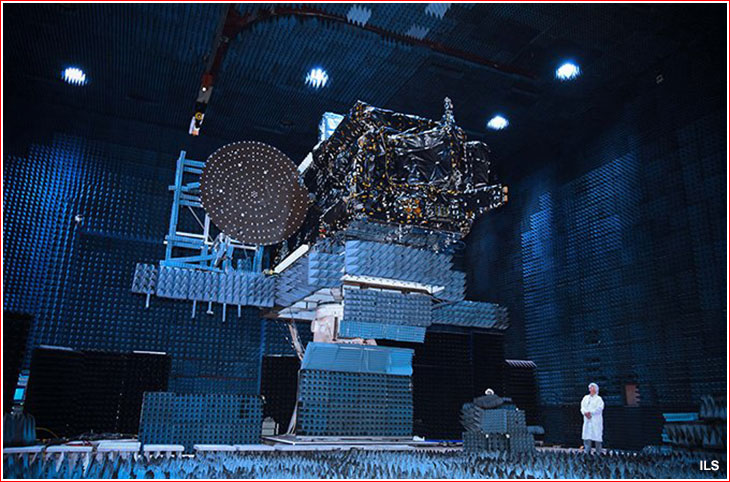
An official photo of the EchoStar-21 satellite shown during acustic testing.
Built by Space Systems Loral, SSL, for EchoStar Corporation of Englewood, Colorado, the nearly 6.9-ton EchoStar-21 satellite (previously known as TerreStar-2 or T2) was designed to provide communications in S-band for next-generation Mobile Satellite Services, MSS. It was reported to be the heaviest satellite launched by the Proton rocket to date. The satellite was to be deployed in the geostationary orbit over the Equator at 10.25 degrees East longitude, where it expected to function for 15 years.
The spacecraft is based on SSL’s standard platform known as SSL-1300. As its main communications payload, EchoStar-21 features a large deployable reflector that will deploy like an umbrella once the satellite is in orbit. EchoStar's subsidiary EchoStar Mobile Limited will utilize a portion of EchoStar-21’s capacity to provide mobile satellite services, MSS, capacity throughout the European Union. EchoStar Mobile is an EU-wide licensee for an integrated mobile satellite service network with a complementary ground component.
Known specifications of the EchoStar-21 satellite:
Next Proton mission: Blagovest
Read (and see) much more on the history of the Russian space program in a richly illustrated, large-format glossy edition:
The article by Anatoly Zak; Last update:August 15, 2017
Page editor: Alain Chabot; Last edit: June 6, 2017
All rights reserved
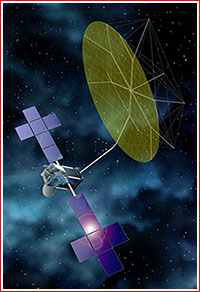
Artist rendering of the Echostar-21 satellite deployed in the geostationary orbit. Credit: Space Systems Loral
)
EchoStar-21 is being prepared for integration with its Briz-M upper stage. Click to enlarge. Credit: Roskosmos
EchoStar-21 and its Briz-M upper stage are lowered into horizontal position prior to encapsulation into the payload fairing. Click to enlarge. Credit: Roskosmos
)
EchoStar-21 is being encapsulated under its payload fairing. Click to enlarge. Credit: Roskosmos
A fully assembled Proton rocket with EchoStar-21 satellite. Click to enlarge. Credit: Roskosmos
)
Proton rocket with EchoStar-21 satellite is loaded onto its transporter-erector in preparation for rollout to the launch pad. Click to enlarge. Credit: ILS
Proton rocket with EchoStar-21 satellite shortly after its installation on the launch pad. Click to enlarge. Credit: Roskosmos






)
)
)
)
)
)
)
)